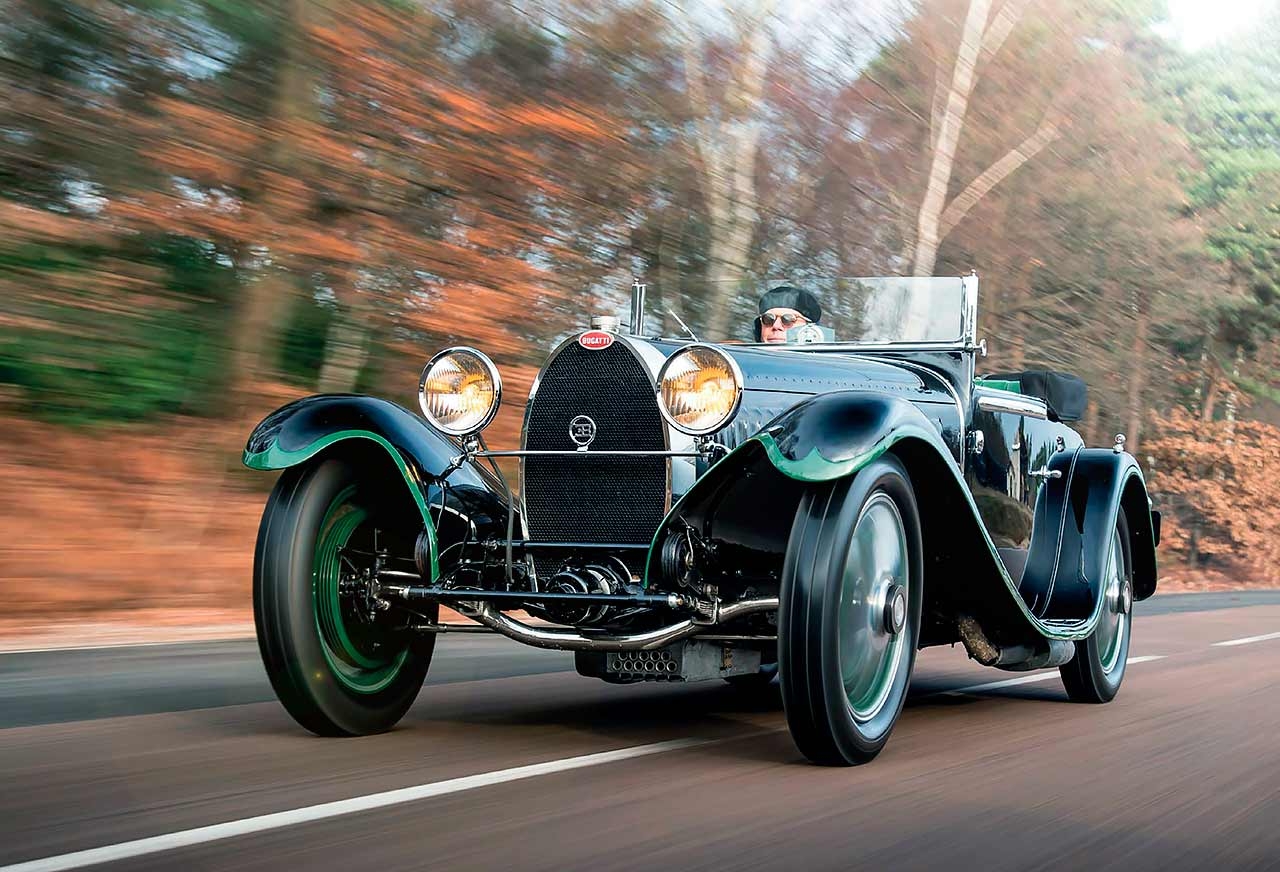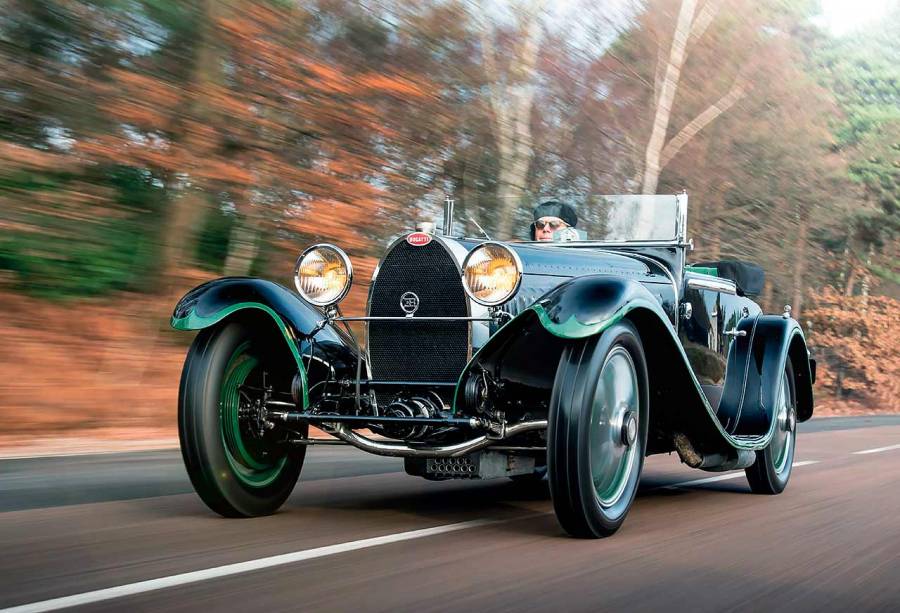
‘It feels neat and neutral, but I’m told it gets tail-happy if you press on’ This amazing T55 was first owned by an eminent surgeon who loved Bugattis and, as Mick Walsh explains, still retains its bespoke coachwork. Photography James Lipman.
UNIQUELY BEAUTIFUL BUGATTI TYPE 55
Mick Walsh takes the wheel of a stunning one-off Bugatti Type 55. Extraordinary Bugatti. This unique Type 55 was built for a discerning French doctor who was one of Molsheim’s most valued clients.
From the green tips of its sweeping wings to the polished castings of its twin rear-mounted spare wheels, this supercharged thoroughbred has the aura of Joan Crawford in a Schiaparelli wrap dress. This elegant little cabriolet reveals just enough of its Grand Prix pedigree.

When a successful French doctor ordered a new Type 55 in 1932, it wasn’t enough for him to drive Molsheim’s quickest road car with beautiful factory bodywork. Jacques Kocher, a hugely respected surgeon, desired something unique, and was willing to pay the substantial extra cost of a custom-designed drophead shell.
The result, built by the little-known coachbuilder Billeter & Cartier, has been prized from the day it arrived at the doctor’s residence on the outskirts of Valence in the summer of assassinations and submarine disasters in France. While much of the country still struggled with the fallout of the Great Depression, the hard-working Kocher enjoyed the spoils of his pioneering research, indulging in fast cars. It would be like turning up at your local hospital today and spotting a bespoke Veyron in the doctor’s space. Back in 1932, with just 38 Type 55s produced, this freshly finished 135bhp, 110mph twin-cam black beauty would have been even more exclusive.
‘IN RECOGNITION OF HIS MEDICAL ADVANCES, KOCHER WAS AWARDED FRANCE’S HIGHEST CIVILIAN HONOUR’
Swing open the deep front-hinged door, and immediately the T51 Grand Prix connections are clear. Below the main wooden dash, with central oval cluster of stylish Jaeger dials, is the distinctive vertical scuttle with a second stage of controls. It’s a snug affair, sitting upright surrounded by olive-green leather trim with your reflection in the deep polished windscreen support, but the view down the bonnet is magnificent with no louvres spoiling the dramatic perspective. Superb details include a hexagonshaped mirror with inset clock figures, no doubt used by Kocher to time his rapid journeys.
The starting routine begins with a critical oil valve for the supercharger, followed by a few pumps of the Ki-Gass to prime a cold engine. After retarding the ignition lever for the Scintilla magneto, the key is pressed in and the engine catches quickly with that glorious cocktail of sounds that equals the Bugatti’s rasping signature score. Best of all is the supercharger whoop that accompanies the crisp action of the accelerator. Before moving off, the blower lubrication needs a few more turns and the hand throttle is adjusted to a steady 1500rpm idle.
The upright lever selects via an H-pattern with first to the top right, but unlike the GP Type 51’s outside change, this T49 touring gearbox has a heavy action through a narrow yet long gate. Even experienced Bugatti pilots find the timing a challenge and clean shifts are euphoric moments. The intense noise from third encourages quick progress to top, but the engine’s lively torque even in high gears makes it such an impressive touring car. The transmission is the most disappointing feature of this remarkable machine, and you soon appreciate why longterm Type 55 owner Neil Corner had Brineton Engineering make a constant-mesh replacement.
Other than its performance edge being handicapped by the heavier bodywork, the rest of the T55 has all the brilliant, taut characteristics of the racers. The steering is direct and precise with lighter weight than an Alfa 8C, its main rival in the early 1930s. After a fast run up an Alpine col, the Bugatti driver would be sweating less because the quicker you go, the better the steering gets. There’s little kickback, even over rough surfaces, despite the scuttle shake induced by bumps.
Thanks to the super-communicative controls, it’s easy to appreciate the car’s thoroughbred handling. Phil Hill tested a T55 against an 8C for Road & Track, and it was 2 secs quicker through the slalom than the Latin exotic. With 0-60mph clocked up in about 10 secs, the T55 could still match a Jaguar XK120 after WW2. Like the 8C, though, it’s the Bugatti’s mid-range punch that really impresses. Within my limits of this valuable machine, the T55 feels addictively neutral and neat, although I’m told that it gets tail-happy – but always controllable – if you press on. The mechanical brakes inspire, too, but they’ll abruptly lock up if pushed too hard and deep. Just like the GP design, they’re easily adjusted because the drum is integral to the wheel casting.
A dream comparison between these fabulous sports cars would be a test against the seductive Brondone-bodied Alfa 8C that also appeared at Rétromobile last month. Picture these two blown, coachbuilt machines roaring side-by-side down Paris or Rome boulevards, dapper drivers hunched over their wheels and Marchal lights warning others of their rapid, raucous pace.
Dr Kocher was one of Bugatti’s best customers and, as a wealthy surgeon, he could indulge in new models each year. French Bugatti historian Pierre-Yves Laugier, himself a doctor with an expert passion for the marque, investigated the factory records and discovered that Kocher ordered 14 during the 1930s. At various times, his Valence home hosted a Type 35, Type 37, Type 44, two Type 43s, Type 50 ‘Profilée’, three Type 57s, a Type 57C, a 1936 Type 57S Atalante straight off the Paris Salon stand, and a Type 57C Atalante with duralumin bodywork.
When a new model was planned, Kocher was no doubt one of the first to learn about its progress. As the Type 55 was developed, Jean Bugatti probably teased the doctor with specification and performance reports during testing. Rather than order a factory body, Kocher opted for Molsheim to supply just a frame that he could take to a preferred coachbuilder.
Early in 1932, Kocher paid FF105,000 for chassis 55206, which in March was delivered to Dache & Pic, the Bugatti dealer in Valence. Kocher was almost certainly its best customer. To design and construct the body, Kocher instructed Billeter & Cartier, a small carrossier based in Lyon. Founded in 1919, this artisan firm focused on high-quality torpédo and limousine bodywork for Berliet and Rochet-Schneider, both local car makers, but occasionally produced one-offs for Bugattis, including a Type 46S.
Kocher discussed his ideas about a more refined body in contrast to the rather exposed but beautiful factory roadster. The design retained the swooping wings that were Jean Bugatti’s trademark style for the radical new model. The costs were high for the bespoke cabriolet, with the doctor eventually paying FF25,000 for the completed coachwork – a quarter of the price of the chassis. The result impressed another local Bugatti driver who contacted Billeter & Cartier about an identical drophead, but the estimated cost is likely to have discouraged the idea.
Although the flowing wings matched the Molsheim T55, the body was unique to Kocher’s cabriolet. From the tall horseshoe-style radiator, a one-piece bonnet stretched right up to the windscreen frame with a chrome strip dividing the bulkhead and the step to the doors. The straight sides offered better protection than the deep cutaway style of the factory roadster, but the hood was folded and exposed on the top of a neat rounded tail. Twin spares on the back and a low windscreen enhanced the lean profile.
Custom details included dual horns and an outside exhaust that dropped swiftly before the scuttle, through the wing and under the running boards. In contrast to the standard bunch of fours, the chromed eight-into-one manifold echoes the design of a Miller Indy racer.
Kocher ordered the bodywork to be painted black, but with green highlights around the sweeping wing edges, matching trim and hood bag. The insides of the wheels were also green. After just six weeks, the Type 55 arrived at his home where the dazzling cabriolet perfectly complemented his sublime T50 Profilée.
Born in 1888, in Crest in the Drôme region, Kocher began his medical career at the hospital in Lyon. After service as a captain in the medical corps during WW1, he rose to the position of head surgeon at the Valence general hospital, but is best known for his modernising surgery equipment – particularly advances in sterilisation and blood transfusion. In recognition of his work, Kocher was awarded the Knight Legion of Honour – the highest civilian tribute in France. His other passion was hunting and he was often invited on shoots by Ettore Bugatti.
Although Kocher still owned a Bugatti as late as 1950, he had a keen interest in other marques, particularly Voisin and Peugeot. He regularly competed during the 1930s, including races at Miramas, Escrinet and St-Romain-de-Lerps, where he won with his Voisin. Living in the midst of the dramatic Rhône-Alps region, he also competed on several rallies.
Kocher kept the Type 55 for longer than most of his Bugattis, and it was clearly a favourite of his ever-changing stable. As well as driving the car to work, it was transport of choice for excursions and holidays. Its breathtaking performance tempted Kocher to enter the Type 55 for various events including the 1933 Rallye des Alpes where it ran in the top class, for cars costing over FF70,000. The tough event was won by Édouard Legré’s Bugatti Type 43, and later the factory named the T57 Galibier after his success in the French mountains. Following the arrival of a new Type 57, the T55 was sold in January 1935.
During the ’50s, Kocher focused on Peugeots, which he enjoyed tuning. Undoubtedly influenced by his Bugatti experience, he even fitted a Constantin Roots-type supercharger to his last 403. Tragically, when returning from a hunting trip in September 1956, Kocher and his wife lost their lives in a road accident. On a well-known black spot at Moulin des Ponts near Coligny, Kocher tried to overtake a 203 and lost control of the car. In the dark, the 403 smashed into trees before rolling twice into the 203.
The Billeter & Cartier Type 55 was bought by Émile Sambuc and his brother Auguste, two successful butchers with a weakness for fast cars. After two years with the Sambucs, the black drophead was a familiar sight around Marseille before it headed to Lille in northern France.
Amazingly, it survived WW2 hidden away in this active battle zone. During peacetime, it was discovered by Ghislain Gengembre, a garage mechanic based south of Lille in Hénin-Liétard. Together with a Type 27 Brescia, the T55 was stored in the back of his workshop where it was noticed by Yves Garnier, a local Bugatti enthusiast. Despite regular approaches, Gengembre refused to sell his prized motors, and only after he died in 1970 did Garnier’s perseverance pay off. The mechanic left instructions in his will that Garnier should be offered both Bugattis and, as soon as the FF50,000 price had cleared, he was straight round to collect the cars.
Over the next 10 years Garnier fastidiously rebuilt the Type 55 himself, and the finished car, still black with its original green interior, featured in Hugh Conway’s Bugatti Magnum book. Peter Agg, the popular moustachioed car fanatic, acquired this unique Type 55 in ’87, and for the first time it came to England to join the Trojan Collection at his Reigate home.
There chassis 55206 kept impressive company with the finest Alfas and Delahayes – together with other Molshiem greats, including Agg’s beloved Type 57S 57541. All of Agg’s vehicles were driven vigorously on rallies all over the world, and the Type 55 was no exception. The car was dispatched to respected Bugatti expert Tula Engineering, which fettled its mechanicals. Agg’s favourite colour was blue, and the Type 55 was duly repainted black with blue body. After road-testing the car around Sussex, Agg shipped the cabriolet to America for the Colorado Grand where it was perfectly suited to the deserted highways around the Rockies, its signature calico-tearing exhaust rasp sounding wonderful through the canyons.
Agg kept the T55 for seven years and drove it on many rallies before selling it to Ruedi Schmid, a Swiss Bugatti connoisseur. Like Agg, Schmid loved driving his cars, in particular the T55. As well as the International Bugatti Rally Italia in 1994, Schmid also ran 55206 at the ’98 Klausenrennen hillclimb – following in the paths of Molsheim racing legends Louis Chiron and Achille Varzi up the spectacular Swiss pass. During Schmid’s ownership, the Type 55 was overhauled by British specialist Gentry Restorations, during which a new Brineton cylinder block was fitted to preserve its original engine.
In 2010, 55206 was acquired by an American collector and rebuilt with guidance from Julius Kruta at the Bugatti factory and historian David Sewell. Bourne-based specialist Hall & Hall was assigned the rebuild, with the bodywork and chassis receiving meticulous attention.
During the stripdown, this T55’s purity was confirmed by Bugatti stampings revealed on key parts, while the Billeter & Cartier body construction was still original. The new owner instructed a repaint in Dr Kocher’s vivid black-and-green livery, including the inside of the distinctive castaluminium eight-spoke wheels. The cockpit was also retrimmed in green leather, just as ordered by the Valence surgeon in 1932 – right down to the hood bag. “Despite it being 85 years old, this is one of the most original Type 55s – thanks to its relatively sheltered life – and retains most of its original components,” confirms Sewell.
The magnificent finished drophead appropriately made its debut in Paris on the Bugatti factory stand at Rétromobile in 2012. It later returned to Molsheim, where it was photographed in front of Château St Jean – the famous family’s ancestral home in Alsace.
The Type 55 is a car to be driven, as such respected marque aficionados Geoffrey St John and Corner continue to prove. I hope this unique Billeter & Cartier cabriolet doesn’t become another concours queen and that future owners use it as Dr Kocher did in the 1930s. Just imagine this supercharged great retracing the route of the 1933 Rallye des Alpes, roaring up the Julier and San Bernardino passes at dawn.
Thanks to Fiskens (www.fiskens.com), David Sewell, Rick Hall and Pierre-Yves Laugier
TECHNICAL DATA FILE BUGATTI TYPE 55
Produced/number built 1931-’1936/ 38
Construction steel ladder chassis, wood body frame with aluminium skin
Engine all-alloy, dual-overhead-camshaft, 2262cc straight-eight, Roots-type supercharger, Zenith 48K carburettor
Max power 135bhp @ 5500rpm
Transmission four-speed crash ’box, RWD
Suspension: front beam axle, semi-elliptic leaf springs rear live axle, reversed torque tube, quarter-elliptics; friction dampers f/r
Steering worm and sector
Brakes 13in drums cast within the wheels
Wheels/tyres cast-aluminium/19in, 5-19s
Wheelbase 9ft ¼ in (2750mm)
Weight 2645lb (1200kg)
0-60mph 10.5 secs
Top speed 110mph
Price new FF130,000
Tall horseshoe-shaped radiator on T55. Note the sublime beam axle, a work of forging craft worthy of any gallery – likewise the beautiful finned sump. Clockwise: cluster of Jaeger dials on main dash with other controls below; centre throttle; elegant mirror with inset clock; straight doors are more practical than draughty roadster; signature wheel with eight-piece wood rim. Clockwise: detuned Type 51 straight-eight delivers c135bhp, twin-cam design reflects Miller practice; distinctive detailing; easyaccess plugs; badge should credit T55 mastermind Jean Bugatti; magneto drive runs off camshaft. The unique Billeter & Cartier cabriolet looks best with the hood raised. Weighty twin spares don’t help with handling, though.






